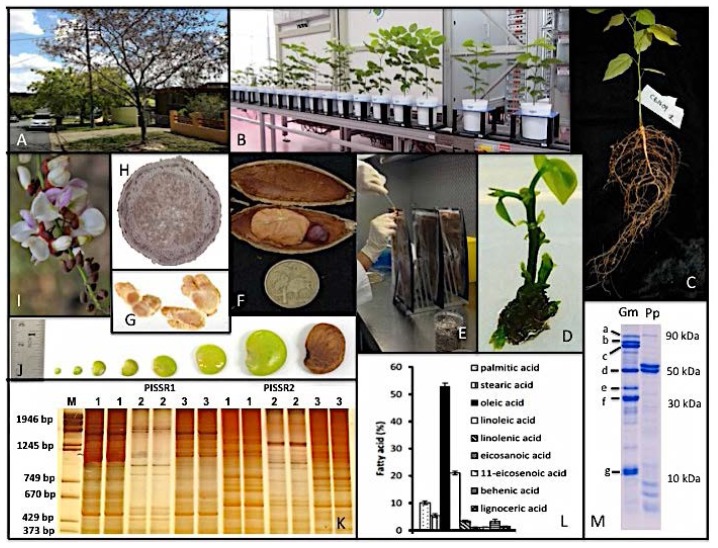Figure 4.
The biological properties of Pongamia, a biofuel feed stock tree with potential. (A) Street trees in Brisbane (Australia) during spring (late November). Note the variable spring leaf burst caused by genetic heterogeneity. Such variation is a problem for the producer, but a benefit to the experimenter; (B) Pongamia plants grown for analysis in the Adelaide Automated Growth Facility; (C) Pongamia seedling plant with nodules induced by Bradyrhizobium japonicum strain CB1809, a common Australian soybean inoculum; (D) Pongamia growing in tissue culture. Clonal regenerants from immature cotyledons are now growing in fields; (E) Pouch growth of Pongamia seedlings allows nodulation studies; (F) Pongamia pod and seed (about 20 mm long seed; about 2 g/seed). Pod casing potential can be co-fired for electricity formation; (G) Pongamia nitrogen-fixing root nodules (about 2–3 mm in length four weeks after inoculation); (H) Pongamia root nodule close-up (about 3 mm in diameter). Bacteria are housed as bacteroids in the interior; (I) Pongamia flowers (pea-like; about 6–8 mm in length); (J) Pongamia seed development: Takes 10–12 months from fertilisation to harvest of dry seed; (K) Pongamia genetic diversity testing. PISSR markers (Pongamia Interstitial Single Sequence Repeats) based genomic DNA sequence separated by polyacrylamide gels electrophoresis and silver stained (Bassam and Gresshoff, Nature Protocols, 2007); (L) Pongamia seed oil composition derived from one seed of tree HS-62; (M) Pongamia seed cake components stained for protein. Left lane: soybean (Gm); right: Pongamia (Pp). (a) lipoxygenase (90 kDa); (b) 7Sα prime (70 kDa); (c) 7Sα (66.4 kDa); (d) 7Sβ conglycinin (51 kDa); (e) 11SAβ (41 kDa); (f) 11SA1a, A1b, A2 (38.5 kDa); (g) sB1a, B1, B2, B3, 11SB4 (10 kDa). The genes for the main Pongamia pinnata seed storage proteins (50 and 52 kDa) were cloned and shown to be similar to the low quality seed storage protein 7S β conglycinin.

